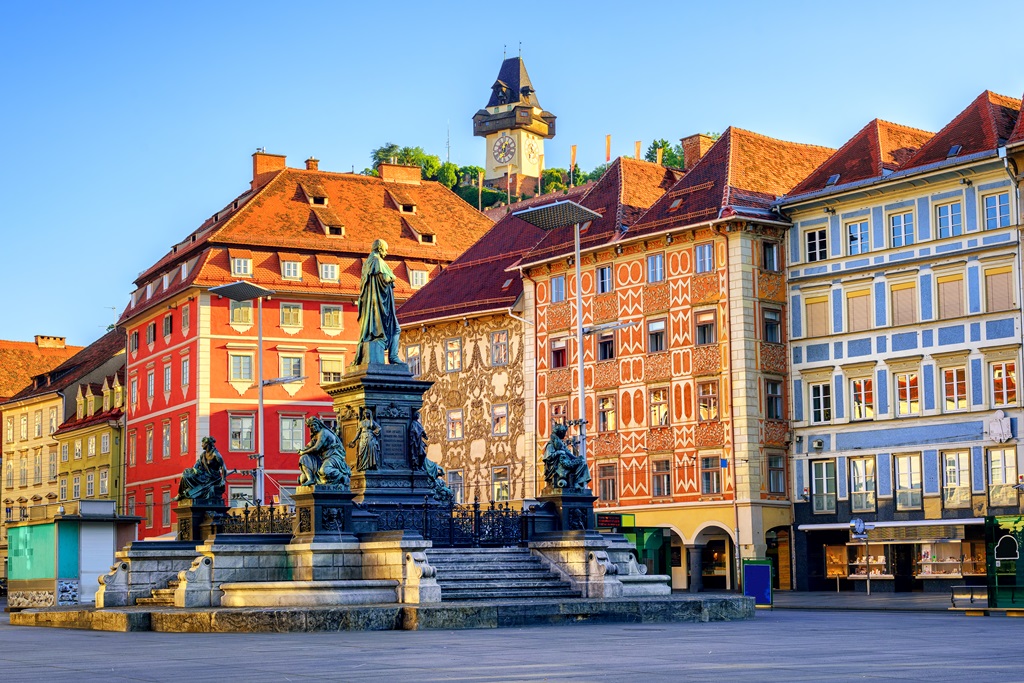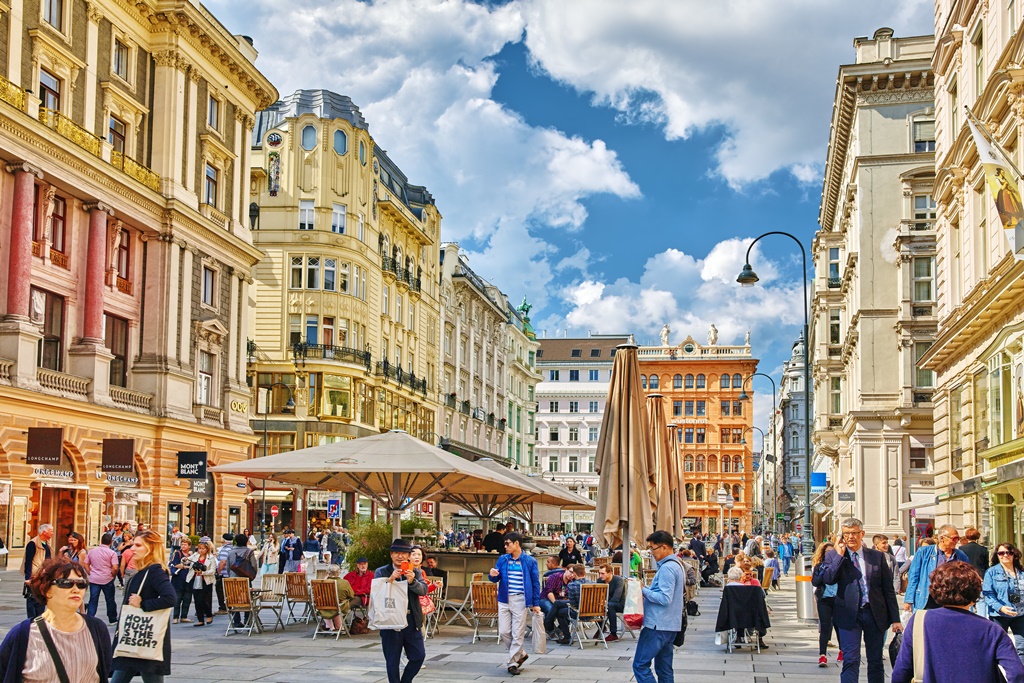UNESCO Sites in Austria
Besides being known as one of the best skiing destinations in Europe, there are lots of other things to do in the home of the Alps. One of them is visiting UNESCO sites. Austria currently has 11 beautiful cultural UNESCO sites and one natural site. Also, Austria has 10 more sites on the Tentative list. If you want to see what this country has to offer apart from winter tourism, check out our guide!
Historic Centre of Salzburg
The city of Salzburg has managed to preserve its fantastic rich urban fabric developed from the Middle Ages to the 19th century. Its Flamboyant Gothic art attracted many craftsmen and artists before the city became even more famous through the work of two Italian architects who are responsible for the city’s Baroque appearance. The fortress of HohenSalzburg dominates the city, and other monumental buildings include the Cathedral, the Residence, the Abbey of St Peter, the Franciscan Abbey and the Domplatz. Also, Salzburg is the birthplace of many important artists and musicians, of which the most well-known one is Wolfgang Amadeus Mozart. In fact, his birth home – called Mozart Geburtshaus in German – is one of the city’s most popular locations.
Historic Centre of Graz
Graz’s Historic Centre and Schloss Eggenberg are a blend of several architectural styles. Precisely, it blends the centuries of architectural styles and movements from the Mediterranean, the Balkans and the Germanic region throughout their history. However, what makes Graz exceptional is how well it blended all of these various styles together. The streets and the sights are harmonious, despite the architectural differences. Today the old town consists of over 1000 buildings, ranging from Gothic to contemporary. The most prominent feature of Graz is the Uhrturm clocktower on Schlossberg Mountain from the early 18th century. The baroque Eggenberg Castle and its gardens, at the western edge of the city, were added to the included area in 2010.
Semmering Railway
Considered Austria’s most scenic route, the Semmering Railway takes you not only to some of Lower Austria’s best spots but also on a journey into the country’s imperial past. In 1841, the Empire encouraged the development of the railway network between Vienna and Trieste. The construction took place between 1848 and 1856, and its main purpose was to overcome a 1 000 m high mountain pass. In fact, Ferdinand von Saar even wrote a famous novel on its construction. At that time, it was the highest altitude a railway had come to. The crucial objective was to integrate it into the surrounding landscape. Therefore, as a consequence, the Semmering area became a popular holiday destination for Vienna’s aristocracy and the spirit of that age has been preserved until today.
Hallstatt-Dachstein Salzkammergut Cultural Landscape
The Salzkammergut region has an exceptional reputation for a reason. Its dramatic scenery with hills, lakes and towns in characteristic architecture make the region one of Austria’s premier tourist attractions. The UNESCO Heritage Site includes the towns of Hallstatt, Gosau, Obertraun and Bad Goisern. Moreover, the area is known for its salt exploitation which dates back to the 2nd millennium BC. Furthermore, Hallstatt has always attracted both active and relaxation-minded travelers thanks to charming bathing lakes and unspoiled mountain scenery. With its bizarre ice caves, varied hiking routes and the Five Fingers viewing platform on Dachstein Mountain is the most popular excursion site in the area.
Palace and Gardens of Schönbrunn
The Palace and Gardens of Austria’s imperial court Schloss Schönbrunn were one of the country’s first Cultural Heritage Sites. Also, Schönbrunn is Austria’s most visited tourist attraction. Interestingly, the castle served as a summer residence for the Habsburg family and was designed after the French palace of Versailles in Paris. The site includes a baroque zoo, the oldest one in the world, state apartments, a smaller palace called Gloriette and a greenhouse known as Palmenhaus. The Palace and Gardens of Schönbrunn are an extraordinary well-preserved example of the Baroque Princely residential ensemble, which constitute an outstanding example of Gesamtkunstwerk, a masterly fusion of many art forms.
Historic Centre of Vienna
Vienna the capital of Austria is a very cosmopolitan city with immigrant communities from all around the globe. The city is situated on the Danube river and is the largest and most important cultural, political and economic centre of this small Alpine country. Vienna is also home to a UNESCO-protected city centre, which today contains many of the city’s main attractions. As such, it provides a perfect opportunity to explore Austria’s three most influential periods of style and architecture, medieval Gothic, early Baroque and neo-Classical styles. However, recently Vienna is on the World Heritage List in Danger due to high-rise projects in the middle of the capital.
Wachau Cultural Landscape
The Wachau is a stretch of the Danube Valley between Melk and Krems, a gorgeous landscape. It has been preserving an intact form of many architectural aspects such as monasteries, castles and ruins, urban design of towns and villages and agricultural use mostly for the cultivation of vines since prehistoric times. It is the region running along the Danube river for about 30 kilometres. During the days of the Babenberg reign, the Wachau area was the centre of medieval culture and played a key role in mission work and counter-reformation. The highlights of the region are the Baroque monasteries of Melk Abbey and Göttweig Abbey and the church and castle of Dürnstein.
Neusiedler See Cultural Landscape
One more place where several cultures met over the centuries is the area around Fertö / Neusiedlersee. The unique nature of the region is dominated by the lake known as Neusiedlersee, ¾ of which lies in Austria, while the rest is in Hungary where it is called Fertö. This area is a real heaven on Earth for cycling enthusiasts as well as for bird lovers. The lake itself is filled with rainwater and usually is suitable for swimming, depending on the temperature. For its depth of only 0,6 – 0,8 meters, this place is Austria’s lowest point. The landscape around the lake is precious for its centuries-old wine tradition, ancient quarries dating to pre-Roman days and characteristic market towns, such as Rust and Mörbisch.
Prehistoric Pile Dwellings around the Alps
Prehistoric pile dwellings around the Alps are the remains of 111 prehistoric dwellings from the period from 5000 to 500 BC. Stilt houses were built on the edges of lakes, rivers and wetlands. Excavations, conducted only in some of the sites, have given evidence which provides insight into prehistoric life, more specifically into the Neolithic and Bronze Age in Alpine Europe and the way communities treated their environment. Half of the sites are located in Switzerland. In Austria, however, you can find them around lake Keutschacher See in Carinthia state, around Lake Attersee in municipalities Litzlberg and Abtsdorf, as well as around lake Mondsee in Upper Austria.
Baden bei Wien
Baden bei Wien is a part of the complex that UNESCO lists as Great Spa Towns of Europe. This charming spa town with a long history became a part of this transnational UNESCO site in 2021. Namely, the organization recognized Baden bei Wien’s long history of spa culture, especially its medical hot springs. Along with them, the town is famous for its beautiful architecture and gardens built around the springs. To be exact, the town has a total of 14 springs. However, there is a lot more to Baden bei Wien. The town lies in the valley of the Schwechat river, and in proximity to the Vienna woods. So, there is a lot of natural beauty to enjoy there, too.
Frontiers of the Roman Empire – The Danube Limes
The Danube Limes, or the Danubian Limes, encompass 600 kilometres of the ancient Roman fortifications along the Danube. The Limes in their entirety stretch throughout 8 different countries. Particularly, in Austria, the western segment of the limes is a part of the UNESCO World Heritage Site and is around 360 kilometres long. Furthermore, the Limes have been a World Heritage site since 2021. This breathtaking fortification dates back to 150 AD and bears witness to Austria’s history and human adaptability. In fact, people didn’t leave the remains at mercy of weather and passage of time. During the Middle Ages, many towns were formed around them, blending ancient architecture with Medieval fashions.
Ancient and Primeval Beech Forests of the Carpathians and Other Regions of Europe
Austria is just one of the 18 countries that are home to temperate beech forests. These quiet, green, undisturbed forests have been living and growing for hundreds of thousands of years. In fact, the scientific evidence proves that the beech forests – in Europe found in 94 different locations – existed long before the last Ice Age. However, after it, the beech forests found themselves in a climate that suited their development. Moreover, they also serve as a home for several ecosystems. The Austrian beech forests are today the only Natural World Heritage Site in the country. Namely, they are also protected naturally as they are within the boundaries of Kalkalpen National Park and Dürrenstein-Lassingtal Wilderness Area.











